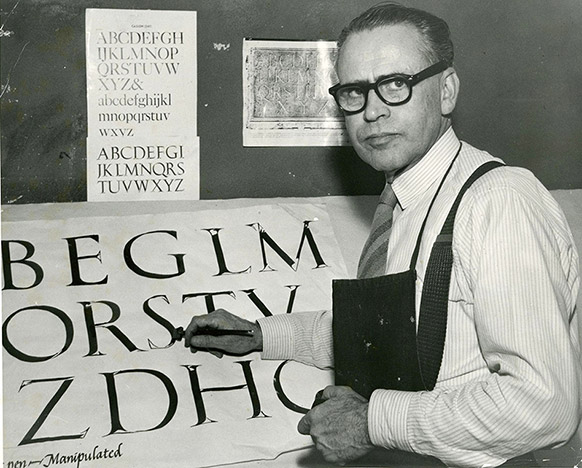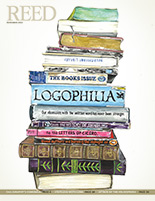
IRIS login | Reed College home Volume 91, No. 4: December 2012
The Books Issue
Rediscovering Lloyd Reynolds

A long-lost calligraphy manual of Lloyd Reynolds is finally published.
By Charles Lehman MAT ’67
After he began teaching at Reed in 1929, Lloyd J. Reynolds privately studied paleography “with pen in hand” and continued to do so for many years thereafter, laying solid historic groundwork for his own calligraphy and teaching of his specialty, italic handwriting. Then in 1954, the scholar-teacher Reynolds revealed himself as a master scribe, publishing his first handwriting manual, Edged Pen Alphabets, a small scholarly booklet including a hand-lettered portfolio of historic and modern letterforms.
In response to the increasing instructional needs of his students, Reynolds then hand lettered a comprehensive set of instructional exercises for italic handwriting and calligraphy for students “of all ages,” Italic Lettering & Handwriting Exercise Book.
According to Richard Abel ’48, then manager of the Reed College bookstore, the exercise manual was produced by Reynolds one page at a time on a mimeograph machine in the faculty room for his students at Reed and the Portland Art Museum. When the pages were made available in the student bookstore, Abel saw sales increasing and even becoming a wholesale item for other bookstores. He and Reynolds then published the exercise manual, the internationally famous “pup-tent,” in 1956 through Lawton-Kennedy in San Francisco.
While drafting a third handwriting manual dealing not only with details of producing italic letter forms but also substantially with the psychology of the scribe at work, Reynolds anticipated its publication in an article, “Free Rhythm and Speed,” published in the Bulletin of the Society for Italic Handwriting (No. 21, Winter 1959–60). In attempting to explain a new exercise to students, which would help provide a rapid transition from set italic to free italic, Reynolds used six folksy expressions, such as “You are trying too hard,” “Get the feel of it,” and “Let go,” to help them adjust their work. Reynolds reported in the article, “I find that it is requiring a booklength exposition to present my method of producing these six attitudes which are necessary to any apprentice to a craft. I am almost through with the first draft, and the book should be off the press by the summer of 1960.”
In spite of the enormous amount of work spent on what is easily his most significant writing, Reynolds chose not to publish his third manual, Italic Lettering, Handwriting & Calligraphy, apparently due to the lukewarm reception given it in private reviews by three scribes/scholars he respected.
The manuscript consists of 102 numbered typescript pages with occasional copy changes pasted into place, numerous handwritten illustrations pasted in place, and many others pasted separately on 13 white boards. It was left upstairs in Reynolds’ desk at the art studio office and discovered after his death in 1978.
In the introduction to his new work, Reynolds explains that his writing is a “text book or craft manual to be used in training teachers and subsequently as a reference and source book by those same teachers in college or high school classes.” Drafted as a companion for use with the highly successful exercise manual, the new book has two major parts. Part one systematically leads the student with thorough commentary and diagrams through the process of learning to write a basic Set italic with an edged pen. Part two leads the learner through various exercises to develop a kind of “thinking and feeling within his hand,” to write with rhythm that will “gain power, grace and expressive potentialities,” and to develop “a feeling for form.”


LATEST COMMENTS
steve-jobs-1976 I knew Steve Jobs when he was on the second floor of Quincy. (Fall...
Utnapishtim - 2 weeks ago
Prof. Mason Drukman [political science 1964–70] This is gold, pure gold. God bless, Prof. Drukman.
puredog - 1 month ago
virginia-davis-1965 Such a good friend & compatriot in the day of Satyricon...
czarchasm - 4 months ago
John Peara Baba 1990 John died of a broken heart from losing his mom and then his...
kodachrome - 7 months ago
Carol Sawyer 1962 Who wrote this obit? I'm writing something about Carol Sawyer...
MsLaurie Pepper - 8 months ago
William W. Wissman MAT 1969 ...and THREE sisters. Sabra, the oldest, Mary, the middle, and...
riclf - 10 months ago